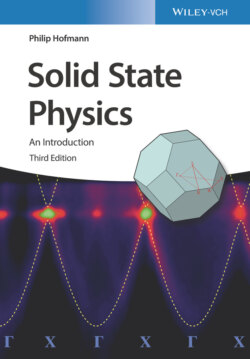Читать книгу Solid State Physics - Philip Hofmann - Страница 16
1.2.1 Cubic Structures
ОглавлениеWe begin with one of the simplest crystal structures possible, the simple cubic structure shown in Figure 1.4a. This structure is not very common among elemental solids, but it is an important starting point for understanding many other structures. Only one chemical element (polonium) is found to crystallize in the simple cubic structure. The structure is unfavorable because of its openness – there are many voids, if we think of the atoms as solid spheres in contact with each other. In metals, which are the most common elemental solids, directional bonding is not important, and a close packing of the atoms is usually favored. We will learn more about this in the next chapter. For covalent solids, on the other hand, directional bonding is important, but six bonds extending from the same atom in an octahedral configuration is highly uncommon in elemental solids.
The packing density of the cubic structure is improved in the body‐centered cubic (bcc) and face‐centered cubic (fcc) structures that are also depicted in Figure 1.4. In fact, the fcc structure has the highest possible packing density for identical spheres, as we shall see later. These two structures are very common – 17 elements crystallize in the bcc structure and 24 elements in the fcc structure. Note that the simple cubic structure ist the only one for which the cube is identical with the Bravais lattice. While the cube is also a unit cell for the bcc and fcc lattices, ist it not the primitive unit cell in these cases. Still, both structures are Bravais lattices with a basis containing one atom, but the vectors spanning these Bravais lattices are not the edges of the cube.
Cubic structures with a more complex basis than a single atom are also important. Figure 1.5 shows the structures of the ionic crystals CsCl and NaCl, which are both cubic with a basis containing two atoms. For CsCl, the structure can be thought of as two simple cubic structures stacked into each other. For NaCl, it consists of two fcc lattices stacked into each other. Which structure is preferred for such ionic crystals depends on the relative size of the positive and negative ions.
Figure 1.5 Structures of CsCl and NaCl. The spheres are depicted much smaller than in the situation of dense packing, but the relative size of the different ions in each structure is correct.
